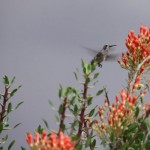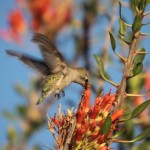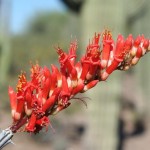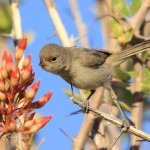Ocotillos in the landscape
Ocotillos (Fouquieria splendens) are used as stunning accent plants in our desert landscapes. These plants develop multiple wand-like stems from the base, creating their characteristic impressive form that can range from 6 to 30 feet in height. The Ocotillo is a great example of the drought-deciduous adaptation to our harsh desert environment. It can drop its foliage multiple times in a summer, looking quite lifeless, and sprout verdant new leaves within 24 to 48 hours after a good soaking rain. Our native Ocotillo typically blooms in the spring, producing tight clusters of brilliant orange-red waxy flowers at the stem tips. These nectar-laden tubes certainly attract the hummingbirds. Even when not in bloom, hummers favor the stem tips for perching and keeping an eye on everything in the garden.
If you are planning on an Ocotillo addition for your garden be aware that they are available as bare root or potted/boxed plants. Bare root specimens are generally less costly, but you have to obtain them from a trustworthy source to insure that they have not been sitting out of the ground for too long and you need to know how to properly plant and care for them. Seed-grown or field-grown Ocotillos are higher priced, but the root system is developed and you can be ensured that the plant will establish quickly. These can range from small 1 gallon size to large boxed specimens.
Ocotillos are often mistakenly considered succulents. Unlike some of their relatives from further south in the Sonoran Desert (the Boojum for example), they are not able to store water in their tissues. They are in fact shrubs and should be cared for as you would other desert shrubs. Include them on the shrub line of your drip irrigation system. Never prune your Ocotillo, as this will destroy its characteristic form by causing unnatural branching of the individual stems. If one is over-reaching its bounds, tame it by removing the errant branches at the base of the plant.
If you suspect that your Ocotillo is dead, look for green within the thorny stems. You can carefully cut away a small piece of the outer bark with a clean sharp knife. If you discover green tissue, the plant is alive. A stem that is dry and brown inside is dead, and you should test some others as well. If it is a recently planted bare root plant that you are worried about, remember that it can take them months to get new roots developed and “come alive” with new foliage.
If you don’t currently have an Ocotillo in your landscape, consider an addition that can become a dramatic focal point to be enjoyed by you and your hummingbird friends.
Kirti Mathura




